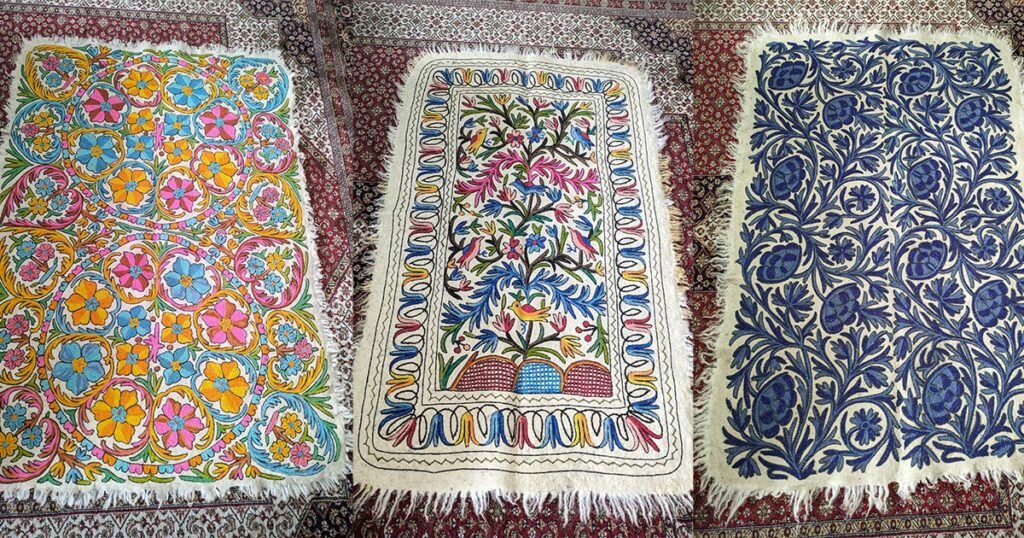Kashmiri Culture
Namda: Weaving Identity and Heritage – A Kashmiri Artistry Tale
Art, when perceived via the lens of a Kashmiri, is an identity. It is not just a means of livelihood but also preserving the legacy and stories of your ancestors. It’s blood, sweat, and hard work that is passed on from one generation to another. This holds especially true for Namda making, an art of Kashmir that is untouched by technological advances and machines. The significance of this 11th-century art has been such that a place called ‘Namdagari Mohalla’ was named after this artwork because of the inhabitants working day in and day out to make beautiful pieces of Namda (rug). Namda rug is used as a floor covering and it’s claimed that some years back, 90% of this rug was exported to foreign countries. The soft and subtle detailing of the warm beauty appealed to people and you would see namdas not just in Kashmiri households but also in the most developed countries.
Let’s revisit Namda through the stories that are associated with it. It’s been said that Emperor Akbar sensed his horse was feeling cold and when some random individual gave him Namda to keep his horse warm, he was beyond impressed. People add that he initiated this art while some claim it came to Kashmir via Yarkand and Iran. Others associate Shah-e-Hamdan with this artwork. And, according to some namda makers, the wool used in the making of namda was used as socks and placed in shoes to protect the feet during Chilai Kalan (coldest 40 days in Kashmir). Namda is warm, beautiful, and a piece of Kashmiri art that holds history in its exquisite detailing.
Namda was initially restricted to men and women claim it was a male-dominated art form. However, gender bias dissolved and women and girls equally started participating in namda making. Some women recall and narrate how they continued to associate with this art all through their lives.
This artwork is purely handmade and demands responsibility, attention, and care. The raw material is the wool from local sheep after which the process of carding is done to ensure it’s free from dirt and other unnecessary additives. The most important process of namda making is the felting of wool. In this process, the wool is spread evenly on gabba (a type of rug). It’s followed by cleaning the wool with a soap that is made locally in Kashmir. Turns out that this soap is purely handmade and only a few people make it. This soap works wonderfully to bind the wool besides cleaning it. Next, boiled water is sprinkled on the wool and this procedure continues until the wool is clean. Depending on the preferences, borders are created. Namda can be with and without fringes. 3 layers are stacked neatly in the same procedure. What follows next is the folding and rolling of these layers using hands and feet. After rolling, it’s again cleaned to ensure no dirt or grime is stuck.
A single namda is made within 3-4 days. It’s white but can be dyed in approximately 25 colors. After dying, a wooden naqsha or mold (prot) is used to make the outline of the imprints on the namda. It’s dipped in a solution of soil and water and each segment of the namda is covered properly. This process also indicates how different art forms are interlinked. If you know about the walnut wood carving of Kashmir, you can get the hint. After this procedure, embroidery is done using long needles with different colored threads to make intricate patterns.
What’s wonderful to note about this Kashmiri artwork is that it’s a community art, wherein different people come together to craft it with perfection. It’s not something an individual can achieve. Locals keenly make and provide the materials that are used to make it. No compromises on quality, time, and effort are made to hasten the process. Isn’t that wonderful that when we have everything available at our fingertips, this artwork still is nurtured and thrives because of the patience of the namda workers. Each step is carefully done and handed over to another worker. This also shows the trust and faith of Namda workers in each other and this art form. Art is collective, indeed.
Another beautiful aspect of this art is the inspiration of namda workers to make the floral patterns. It seems the landscape of Kashmir is etched deeply in the minds of the workers and they attempt to recreate it so that whoever gets the namda, senses the vividness of nature. So, even if this rug is laid on a floor, it reminds you of the outdoors, of nature, and the diversity of Kashmir.
Namda is special to Kashmir because the patterns resemble the liveliness and color schemes of this place. Art, inspiration, and imagination come together to weave this bundle of warmth, color, and hard work. And, even if this is an ancient art, there are attempts to preserve it, nurture it, and protect the process from the rush and shortcuts the world is heading towards.
Kashmir’s art is also one of the reasons that makes this place truly blessed. And, as per the workers, ‘you’ll get rugs everywhere but you won’t get Kashmiri rug anywhere.’ It’s a part of being Kashmiri. It’s a message of staying connected to the roots even though the financial benefits may not be as promising. Art thrives, sustains, and lives on. However, it’s upon us also, to take time and understand art deeply and appreciate the process.
Shop Kashmiri Namdas here
Article by Aiman Khan

